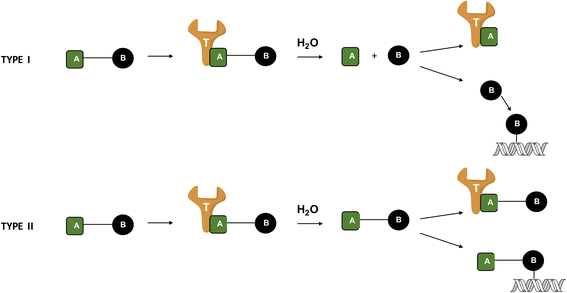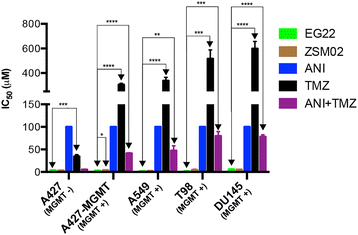A type I combi-targeting approach for the design of molecules with enhanced potency against BRCA1/2 mutant- and O6-methylguanine-DNA methyltransferase (mgmt)- expressing tumour cells
- PMID: 28800752
- PMCID: PMC5553999
- DOI: 10.1186/s12885-017-3504-1
A type I combi-targeting approach for the design of molecules with enhanced potency against BRCA1/2 mutant- and O6-methylguanine-DNA methyltransferase (mgmt)- expressing tumour cells
Abstract
Background: Mutations of the DNA repair proteins BRCA1/2 are synthetically lethal with the DNA repair enzyme poly(ADP-ribose) polymerase (PARP), which when inhibited, leads to cell death due to the absence of compensatory DNA repair mechanism. The potency of PARP inhibitors has now been clinically proven. However, disappointingly, acquired resistance mediated by the reactivation of wild type BRCA1/2 has been reported. In order to improve their efficacy, trials are ongoing to explore their combinations with temozolomide (TMZ). Here, in order to enhance potency in BRCA1/2-mutant cells, we report on the design of single molecules termed "combi-molecules" capable of not only inhibiting PARP but also damaging DNA like TMZ, which is known to induce a large number of DNA adducts. The majority of these lesions are processed through PARP-dependent base-excision repair machinery. Paradoxically, the least abundant lesion, the O6-methylguanine adduct is the most cytotoxic. Its repair by the O6-methylguanine DNA methyl transferase (MGMT) confers robust resistance to TMZ. Thus, we surmise that a combi-molecule designed to generate the same DNA adducts as TMZ, with an additional ability to block PARP, could induce BRCA1/2 mutant selective potency and a growth inhibitory profile independent of MGMT status.
Methods: The hydrolysis of EG22 and its stabilized form ZSM02 was analyzed by HPLC and fluorescence spectroscopy. Growth inhibitory potency was determined by SRB assay. PARP inhibition was determined by an enzyme assay and DNA damage by the comet assay. Subcellular distribution was visualized by confocal microscopy.
Results: Studies on EG22 showed that: (a) it inflicted anomalously higher levels of DNA damage than TMZ (b) it induced PARP inhibitory potency in the same range as ANI, a known PARP inhibitor (IC50 = 0.10 μM) (c) it showed strong potency in both BRCA1/2 wild type and mutated cells with 6-fold selectivity for the mutants and it was 65-303-fold more potent than TMZ and 4-63-fold than ANI alone and 3-47-fold than their corresponding equimolar combinations and (d) its potency was independent of MGMT expression.
Conclusion: The results in toto suggest that a combi-molecular approach directed at blocking PARP and damaging DNA can lead to single molecules with selective and enhanced potency against BRCA1/2 mutant and with activity independent of MGMT, the major predictive biomarker for resistance to TMZ.
Keywords: 1,2,3-methyltriazene; BRCA1/2 reactivation; Chemoresistance; Combi-targeting; DNA repair; MGMT; PARP inhibitor; Temozolomide.
Conflict of interest statement
Ethics approval and consent to participate
Ethics approval was not required for the use of human cell lines in this study.
Consent for publication
Not applicable.
Competing interests
The authors declare that they have no competing interests.
Publisher’s Note
Springer Nature remains neutral with regard to jurisdictional claims in published maps and institutional affiliations.
Figures










Similar articles
-
PARP-mediated PARylation of MGMT is critical to promote repair of temozolomide-induced O6-methylguanine DNA damage in glioblastoma.Neuro Oncol. 2021 Jun 1;23(6):920-931. doi: 10.1093/neuonc/noab003. Neuro Oncol. 2021. PMID: 33433610 Free PMC article.
-
Temozolomide: mechanisms of action, repair and resistance.Curr Mol Pharmacol. 2012 Jan;5(1):102-14. doi: 10.2174/1874467211205010102. Curr Mol Pharmacol. 2012. PMID: 22122467
-
Certain imidazotetrazines escape O6-methylguanine-DNA methyltransferase and mismatch repair.Oncology. 2011;80(3-4):195-207. doi: 10.1159/000327837. Epub 2011 Jul 1. Oncology. 2011. PMID: 21720182
-
PARP inhibitors in breast cancer: Bringing synthetic lethality to the bedside.Cancer. 2018 Jun 15;124(12):2498-2506. doi: 10.1002/cncr.31307. Epub 2018 Apr 16. Cancer. 2018. PMID: 29660759 Free PMC article. Review.
-
O6-methylguanine DNA methyltransferase as a promising target for the treatment of temozolomide-resistant gliomas.Cell Death Dis. 2013 Oct 24;4(10):e876. doi: 10.1038/cddis.2013.388. Cell Death Dis. 2013. PMID: 24157870 Free PMC article. Review.
Cited by
-
Molecular analysis of the dual targeting of the epidermal growth factor receptor and the O6-methylguanine-DNA methyltransferase with a double arm hybrid molecule.Oncotarget. 2018 Oct 12;9(80):35041-35055. doi: 10.18632/oncotarget.25120. eCollection 2018 Oct 12. Oncotarget. 2018. PMID: 30416678 Free PMC article.
-
15N-, 13C- and ¹H-NMR Spectroscopy Characterization and Growth Inhibitory Potency of a Combi-Molecule Synthesized by Acetylation of an Unstable Monoalkyltriazene.Molecules. 2017 Jul 19;22(7):1183. doi: 10.3390/molecules22071183. Molecules. 2017. PMID: 28753938 Free PMC article.
-
Development of Novel Pyridine-Thiazole Hybrid Molecules as Potential Anticancer Agents.Molecules. 2022 Sep 21;27(19):6219. doi: 10.3390/molecules27196219. Molecules. 2022. PMID: 36234755 Free PMC article.
-
Autophagy deficiency downregulates O6methylguanine-DNA methyltransferase and increases chemosensitivity of liver cancer cells.Aging (Albany NY). 2021 May 24;13(10):14289-14303. doi: 10.18632/aging.203044. Epub 2021 May 24. Aging (Albany NY). 2021. PMID: 34031266 Free PMC article.
-
A Prospective Clinical Study on MGMT Protein Expression and the Effect of Gene Promoter Methylation on Sensitivity to Chemotherapeutics in Spinal Glioma.J Inflamm Res. 2021 Sep 18;14:4777-4784. doi: 10.2147/JIR.S321790. eCollection 2021. J Inflamm Res. 2021. PMID: 34566423 Free PMC article.
References
-
- Sultana R, McNeill DR, Abbotts R, Mohammed MZ, Zdzienicka MZ, Qutob H, Seedhouse C, Laughton CA, Fischer PM, Patel PM, et al. Synthetic lethal targeting of DNA double-strand break repair deficient cells by human apurinic/apyrimidinic endonuclease inhibitors. Int J Cancer. 2012;131(10):2433–2444. doi: 10.1002/ijc.27512. - DOI - PMC - PubMed
-
- Audeh MW, Carmichael J, Penson RT, Friedlander M, Powell B, Bellmcguinn KM, Scott C, Weitzel JN, Oaknin A, Loman N, et al. Oral poly(ADP-ribose) polymerase inhibitor olaparib in patients with BRCA1 or BRCA2 mutations and recurrent ovarian cancer: a proof-of-concept trial. Lancet. 376(9737):245–51. - PubMed
MeSH terms
Substances
LinkOut - more resources
Full Text Sources
Other Literature Sources
Research Materials
Miscellaneous

